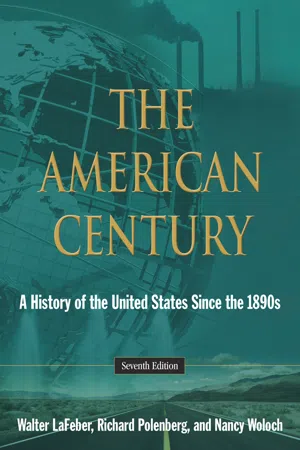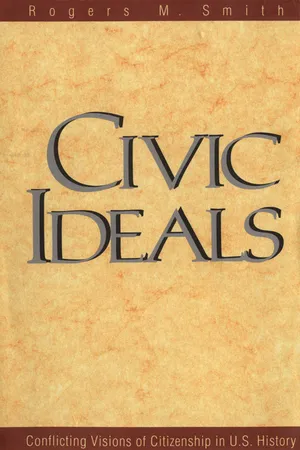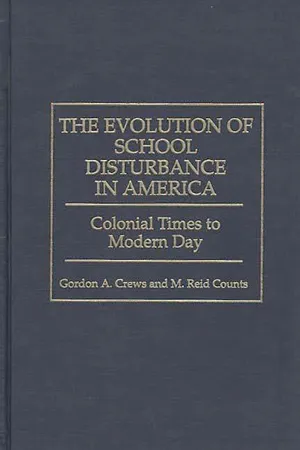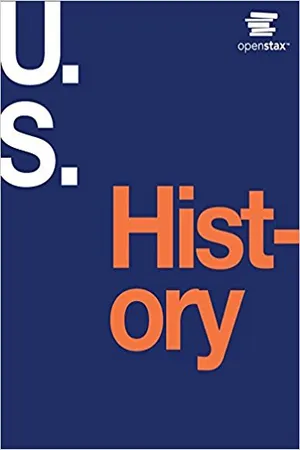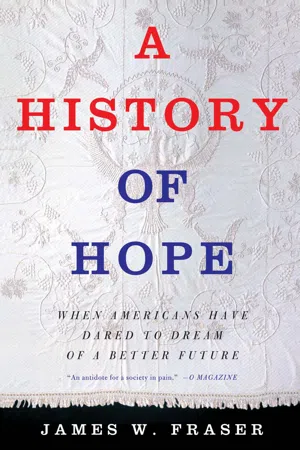History
The Progressive Era
The Progressive Era in the United States, spanning from the late 19th century to the early 20th century, was characterized by social and political reform efforts aimed at addressing issues such as corruption, inequality, and industrialization. Key initiatives included the regulation of big business, labor reforms, women's suffrage, and the conservation of natural resources. This period marked a significant shift towards a more activist government and a focus on social welfare.
Written by Perlego with AI-assistance
Related key terms
1 of 5
9 Key excerpts on "The Progressive Era"
- No longer available |Learn more
The American Century
A History of the United States Since the 1890s
- Walter LaFeber, Richard Polenberg, Nancy Woloch(Authors)
- 2015(Publication Date)
- Taylor and Francis(Publisher)
HAPTER TWO 1900—1917The Progressive EraSuffragists on a picket line in front of the White House. One banner reads, "Mr. President How Long Must Women Wait For Liberty." (Library of Congress)An interest in reform has always characterized American history. What varied over time has been the things people identified as evils, the intellectual justifications and political techniques used to eradicate those evils, the obstacles reformers encountered, and the degree of support those reforms received. Seldom has a larger proportion of the population favored social improvement than during the opening years of the twentieth century, when Americans first tried in a systematic way to control the forces of industrialization and urbanization. Because the United States was becoming a major world power, the successes and failures of the Progressive movement affected not only Americans but also people around the world.The Reform Impulse
Although progressivism followed on the heels of the Populist revolt and sometimes echoed certain Populist demands, the two movements differed in important respects. Populism had drawn support primarily from farmers and had always remained a sectional force; progressivism won backing from city dwellers, including the middle classes, and had as wide a following in New York and California as in Kansas and South Carolina. Populists had sought for the most part to improve conditions in the countryside; Progressives devoted considerably more attention to political and social problems in the cities. Precisely because Progressives drew on a wider constituency and were concerned with a broader range of issues, they achieved a measure of influence at the city, state, and national levels that had eluded the Populists.Progressives did, however, pay a price for this success. So many different people wanting so many disparate things styled themselves "Progressives" that the movement often seemed to lack a clearly defined program. Progressivism attracted surprisingly diverse groups: small businessmen who favored a curb on monopolies, and big businessmen who sought to extend their economic influence and eliminate their competitors; native Americans who feared the influx of eastern European immigrants, and settlement-house workers who appreciated the newcomers' contributions to American culture; southern whites dedicated to the preservation of Jim Crow, and northern blacks just as fully committed to its eradication; social scientists who believed that planning held all the answers to human progress; and prohibitionists who imagined that closing the saloons would usher in a new world. - eBook - PDF
- Paul Boyer, Clifford Clark, Karen Halttunen, Joseph Kett(Authors)
- 2017(Publication Date)
- Cengage Learning EMEA(Publisher)
The Progressive Era, 1900–1917 Progressives and Their Ideas (590) How did intellectuals, novelists, and journalists inspire the progressive movement? The Many Faces of Progressivism Intellectuals Offer New Social Views Novelists, Journalists, and Artists Spotlight Social Problems Grassroots Progressivism (594) How did state and local progressives seek to reform cities and the new industrial order? Reforming Local Politics Regulating Business, Protecting Workers Making Cities More Livable Progressivism and Social Control (597) How did progressives try to control morality, and how did they view immigrants and blacks? Urban Amusements; Urban Moral Control Battling Alcohol and Drugs Immigration Restriction and Eugenics Racism and Progressivism Blacks, Women, and Workers Organize (602) What strategies did African Americans, women, and industrial workers use to improve their lot? African American Leaders Organize Against Racism Revival of the Woman-Suffrage Movement Enlarging the “Woman’s Sphere” Workers Organize; Socialism Advances National Progressivism: Roosevelt, Taft, and Wilson, 1901–1917 (608) As progressivism became a national movement, what issues proved most important? Roosevelt’s Path to the White House Consumer Protection and Environmentalism: Progressive Style Taft in the White House, 1909–1913 The Four-Way Election of 1912 Woodrow Wilson’s First Challenges: Tariff and Banking Reform Business Regulation and the Supreme Court 1916: Wilson Edges Out Hughes The Whole Vision (618) 21 MULBERRY STREET ON NEW YORK CITY’S LOWER EAST SIDE, AROUND 1900 (Library of Congress Prints & Photographs Division [LC-USZC4-4637]) Copyright 2018 Cengage Learning. All Rights Reserved. May not be copied, scanned, or duplicated, in whole or in part. WCN 02-300 589 YOUNG FEMALE GARMENT WORKER, 1915, PHOTOGRAPHED BY LEWIS W. HINE (Granger, NYC) CHRONOLOGY 1900–1917 1900 International Ladies’ Garment Workers’ Union (ILGWU) founded. - eBook - PDF
Civic Ideals
Conflicting Visions of Citizenship in U.S. History
- Rogers M. Smith(Author)
- 2008(Publication Date)
- Yale University Press(Publisher)
12 Progressivism and the New American Empire, 1898-1912 Though scholars dispute what progressivism was, few deny that both major parties and American politics generally changed dur-ing the first two decades of the twentieth century in ways that com-prise a distinct Progressive Era. The impact of the range of politi-cal, social, and intellectual movements that may be termed progressivism is proven by the 1912 election. 1 In it a Progressive third-party candidate, Theodore Roosevelt, ran against Democrat Woodrow Wilson, who espoused a less nationalistic version of pro-gressivism, and against Roosevelt's former protege, Republican William Howard Taft, a conservative who still supported many of Roosevelt's reforms. Though he was by then reviled by followers of the other two, even Taft falls in a lineage that deserves to be termed right progressivism. Conversely, the surprisingly successful So-cialist candidate that year, Eugene V. Debs, had long shared many positions with left progressives, though he remained more radical. After Wilson won, he set about implementing his version of pro-gressivism until World War I interrupted and modified those ef-forts, sharpening their nationalistic and anti-socialist elements in ways that would have an enduring impact on American citizenship in the twentieth century. 2 Important as those later developments were, by 1912 all the main reformulations of American civic ideologies that would com-pete in the rest of the twentieth century were already visible. They confirm beyond question the persistent, often resurgent appeal of inegalitarian ascriptive civic ideologies, along with egalitarian lib-eral and republican themes, in American politics. Hence it is in 1912 that this historical survey will close. This point is admittedly a bit arbitrary, for the Progressive years represented only the deep- - eBook - PDF
The Evolution of School Disturbance in America
Colonial Times to Modern Day
- M. Reid Counts, Gordon A. Crews(Authors)
- 1997(Publication Date)
- Praeger(Publisher)
5 Progressive School Era, 1860-1960 The next 100 years of U.S. history represented not only the second major education reform era but also a major era of reform in U.S. society. Commonly referred to as "progressivism," it is what J. Carper (1995) refers to as "a label for a wide variety of activities directed toward chang- ing American social, political, and institutional behavior roughly between 1890 and 1920 in response to concern about a myriad of problems associ- ated with immigration, economic competition, rapid urbanization, farm outmigration, monopolies, political corruption, economic instability, spectre of class conflict, privilege, social unrest, and plight of children" (p. 31). The period between 1860 and 1960 would also see many drastic changes in juvenile behavior in society and, therefore, changes in school disturbances. During this time, control of classrooms would evolve from a tight structure around all student movement, to disciplinary classrooms and expulsion, to armed and uniformed police officers being placed in school buildings. School disturbance would increase drastically, causing these increased control mechanisms. SOCIAL DEVELOPMENTS The progressive school era saw massive reforms in all areas of public life, including the institution of pure food and drug laws, direct election of 60 EVOLUTION OF SCHOOL DISTURBANCE IN AMERICA Senators, women's suffrage, child labor laws, civil service reform, Prohibition, trust busting, city manager government, sanitation reform, and tenement regulations (Carper, 1995). Major events of the era such as the Civil War, the Major Depression, the Great Depression, World War I, and World War II affected views on education. The Great Depression, in particular, had specific impact on schools and society. Some argued that society needed to reconstruct itself and create a new social order; this was to be done by schooling. The Depression affected the entire country; it was not bound by geographic lines. - eBook - PDF
- P. Scott Corbett, Volker Janssen, John M. Lund, Todd Pfannestiel, Paul Vickery, Sylvie Waskiewicz(Authors)
- 2014(Publication Date)
- Openstax(Publisher)
For three decades, suffragist groups pushed for legislation to give women the right to vote in every state. As the illustration above shows (Figure 21.1), the western states were the first to grant women the right to vote; it would not be until 1920 that the nation would extend that right to all women. Chapter 21 | Leading the Way: The Progressive Movement, 1890-1920 601 21.1 The Origins of the Progressive Spirit in America By the end of this section, you will be able to: • Describe the role that muckrakers played in catalyzing The Progressive Era • Explain the main features of Progressivism The Progressive Era was a time of wide-ranging causes and varied movements, where activists and reformers from diverse backgrounds and with very different agendas pursued their goals of a better America. These reformers were reacting to the challenges that faced the country at the end of the nineteenth century: rapid urban sprawl, immigration, corruption, industrial working conditions, the growth of large corporations, women’s rights, and surging anti-black violence and white supremacy in the South. Investigative journalists of the day uncovered social inequality and encouraged Americans to take action. The campaigns of the Progressives were often grassroots in their origin. While different causes shared some underlying elements, each movement largely focused on its own goals, be it the right of women to vote, the removal of alcohol from communities, or the desire for a more democratic voting process. THE MUCKRAKERS A group of journalists and writers collectively known as muckrakers provided an important spark that ignited the Progressive movement. Unlike the “yellow journalists” who were interested only in sensationalized articles designed to sell newspapers, muckrakers exposed problems in American society and urged the public to identify solutions. - eBook - PDF
- John E. Findling, Frank W. Thackeray, John E. Findling, Frank W. Thackeray(Authors)
- 2010(Publication Date)
- ABC-CLIO(Publisher)
A variety of essays analyzing The Progressive Era from different perspectives. Harbaugh, William H. The Life and Times of Theodore Roosevelt. New York: Collier, . Bal- anced biography of the president most closely associated with progressivism. Hareven, Tamara K., and Randolph Langenbach. Amoskeag: Life and Work in an American Factory-City. New York: Pantheon Books, . A case study of management and labor in what was the world’s largest textile factory. Harrison, Robert. Congress, Progressive Reform, and the New American State. New York: Cam- bridge University Press, . Study of the role of Congress in legislating Progressive reform measures. Hofstadter, Richard. The Age of Reform: From Bryan to F.D.R. New York: Vintage Books, . Classic analysis of American politics in the early th century. Kolko, Gabriel. The Triumph of Conservatism: A Reinterpretation of American History, – . New York: Free Press, . Argues that the Progressive-era reforms were really just what conservative forces wanted. Lamoreaux, Naomi R. The Great Merger Movement in American Business, –. Cam- bridge: Cambridge University Press, . A statistical analysis of the business combination movement at the turn of the th century and its impact on antitrust activity. Link, William A. The Paradox of Southern Progressivism, –. Chapel Hill: University of North Carolina Press, . Argues that Southern Progressives had only limited success be- cause they tried to impose reform through coercion and control. McCormick, Richard L. From Realignment to Reform: Political Change in New York State, – . Ithaca, NY: Cornell University Press, . Study of the impact of progressivism on an important northeastern state. McCormick, Richard L. The Party Period and Public Policy: American Politics from the Age of Jackson to The Progressive Era. New York: Oxford University Press, . A study of the changes brought by Progressive politics on U.S. - eBook - PDF
A History of Hope
When Americans Have Dared to Dream of a Better Future
- NA NA(Author)
- 2016(Publication Date)
- Palgrave Macmillan(Publisher)
Lawrence A. Cremin, in his study of progressivism in education, comes much closer to an accurate understanding of the movement. “The word progressive provides the clue to what it really was: the educational phase of American Pro- gressivism writ large. In effect, progressive education began as Progressivism in education: a many-sided effort to use the schools to improve the lives of in- dividuals.” 46 And, it must be added, a fierce confidence that such an effort could succeed—for students, teachers, and the larger society. In fact, progressive education meant many different things to different people. For some business-oriented reformers, it meant reorganizing schools to 205 THE MANY FACES OF The Progressive Era be more businesslike with centralized administrations and bureaucratic top- down modes of decision making. For militant teachers, it meant the exact op- posite: a restructuring of schools to give teachers more voice and more influence in all aspects of education, moving them from being mere cogs to the center of the action. For yet others, the focus was not structure at all, but the child him- or herself. For these child-centered progressives, what schools needed was a shift in emphasis from the curriculum and teaching to the learner and the complex process of learning and truly knowing. For yet others who called themselves progressives, progressivism meant making education scien- tific and especially including scientific measurement—usually through stan- dardized testing—into the life of schools. Finally, for social radicals, progressive education meant transforming both the school and the larger society, using the school to build in microcosm the kind of larger society that, in Dewey’s words, was worthy, lovely, and harmonious. With all these and yet other educators calling themselves progressives, it is, indeed, fair to say that the term progres- sive education is too broad to have meaning. - eBook - PDF
A People and a Nation
A History of the United States
- Jane Kamensky, Carol Sheriff, David W. Blight, Howard Chudacoff(Authors)
- 2017(Publication Date)
- Cengage Learning EMEA(Publisher)
Settlement houses in northern cities kept blacks and whites apart in separate programs and buildings. Progressive reformers generally occupied the center of the ideological spectrum. Moderate, socially aware, sometimes contradictory, they believed on one hand that laissez-faire was obsolete and on the other that a radical departure from free enterprise was dangerous. Like Thomas Jefferson, they expressed faith in the conscience and will of the people; like Alexander Hamilton, they desired strong central government to act in the interest of conscience. Their goals were both idealistic and realistic. As minister-reformer Walter Rauschenbusch wrote, “We shall demand perfection and never expect to get it.” 18-2 Government and Legislative Reform ▶ ▶ How did government become more active in society during The Progressive Era? ▶ ▶ What steps were taken by reformers to make government more efficient? ▶ ▶ How did reformers address concerns about matters of social and individual morality? Mistrust of tyranny had traditionally prompted Americans to believe that democratic government should be small, interfere in private affairs only in unique circumstances, and withdraw when balance had been restored. But in the late 1800s, this laissez-faire viewpoint weakened when problems resulting from economic change seemed to over- whelm individual effort. Corporations pursued government aid and protection for their enterprises. Discontented farm- ers sought government regulation of railroads and other monopolistic businesses. And city dwellers, accustomed to favors performed by political machines, came to expect government to act on their behalf. Before 1900, state gov- ernments had been concerned largely with railroads and economic growth; the federal government had focused pri- marily on tariffs and the currency. But after 1900, issues of regulation, both economic and social, demanded attention. More than in the past, public opinion, roused by muckrak- ing media, influenced change. - Elizabeth Cobbs, Edward Blum, Jon Gjerde, , Elizabeth Cobbs, Edward Blum, Jon Gjerde(Authors)
- 2016(Publication Date)
- Cengage Learning EMEA(Publisher)
Some of them never found a consis-tent referential language even for themselves. William Beveridge referred to THE PROGRESSIVE MOVEMENT 151 Copyright 2017 Cengage Learning. All Rights Reserved. May not be copied, scanned, or duplicated, in whole or in part. Due to electronic rights, some third party content may be suppressed from the eBook and/or eChapter(s). Editorial review has deemed that any suppressed content does not materially affect the overall learning experience. Cengage Learning reserves the right to remove additional content at any time if subsequent rights restrictions require it. himself variously as a “ Tory democrat, ” a “ Labour imperialist, ” “ very nearly ” a socialist, and a Liberal. Frederic C. Howe, the American municipal reformer, called himself a single-taxer, a “ liberal, ” a “ reformer, ” and a “ radical. ” . … One comes close to a common denominator, however, with “ progressive. ” As a political designation it was English before it was American, born in the heated municipal politics of 1890s London before crossing to the United States in the first decade of the new century. … By the first decade of the twentieth century there was no party system within the North Atlantic economy that had not been profoundly shaken by the new social politics. In Britain, the Liberal government of 1906 – 1914 em-barked on a flurry of legislation that, a quarter century later, still stuck in Franklin Roosevelt ’ s mind for its daring.
Index pages curate the most relevant extracts from our library of academic textbooks. They’ve been created using an in-house natural language model (NLM), each adding context and meaning to key research topics.
